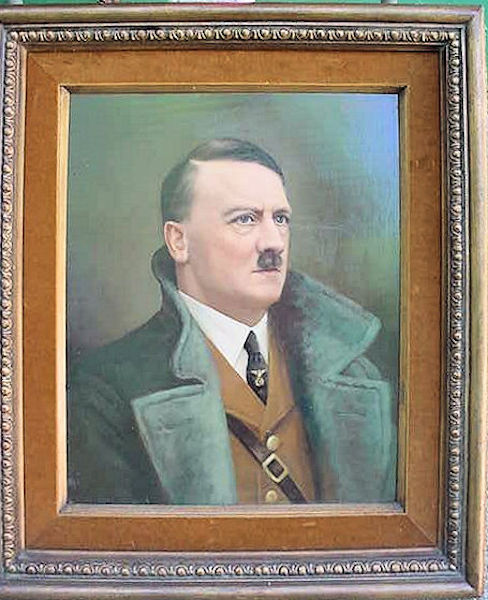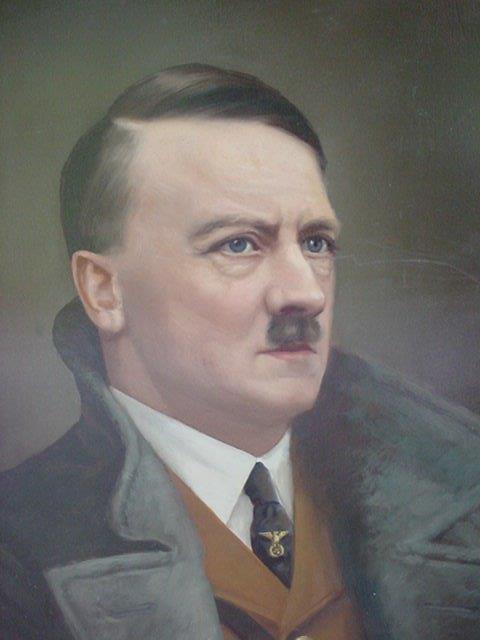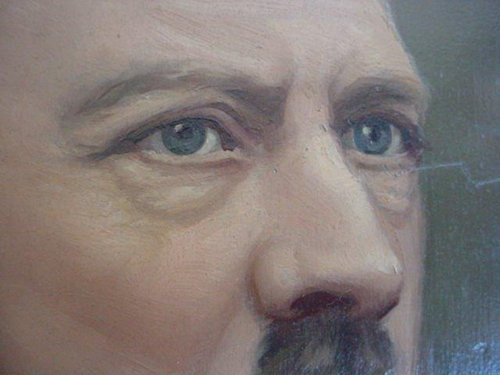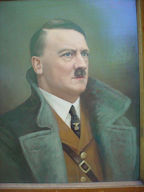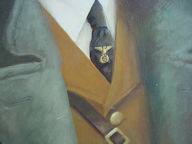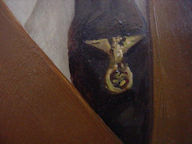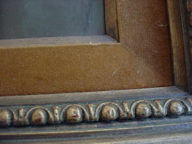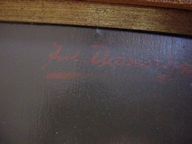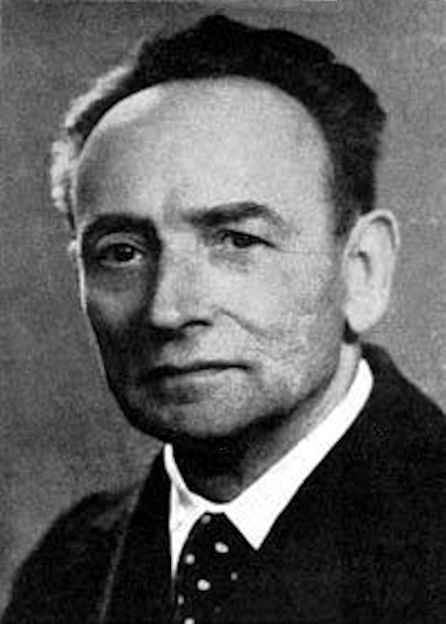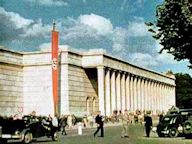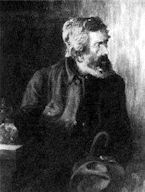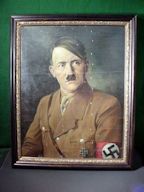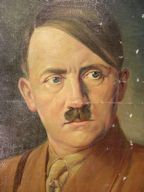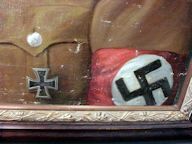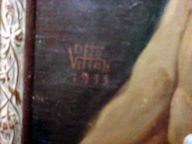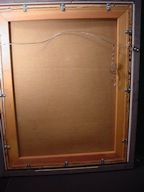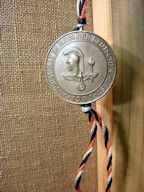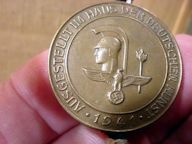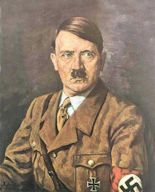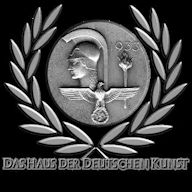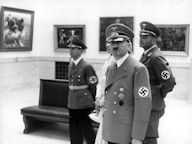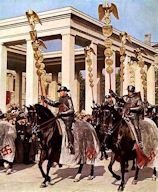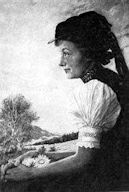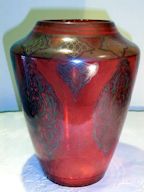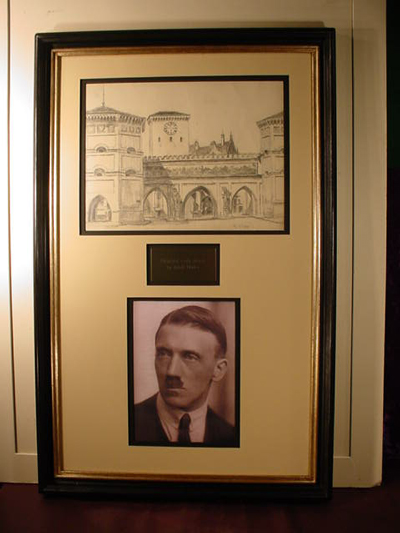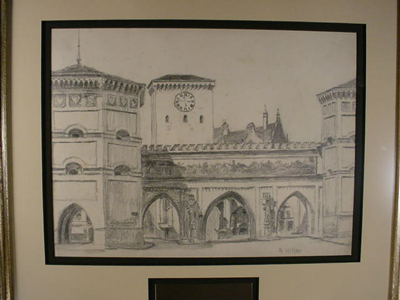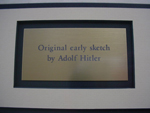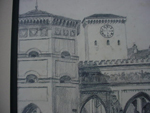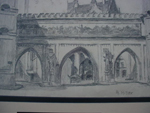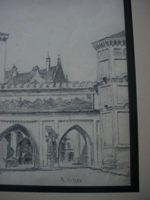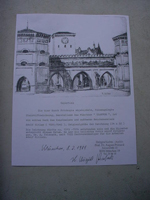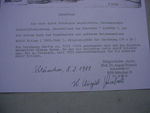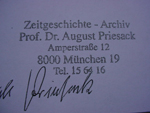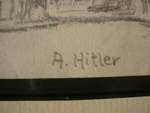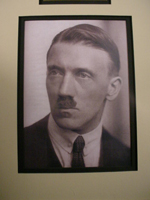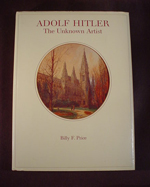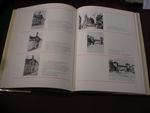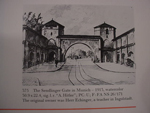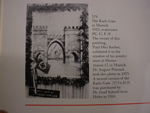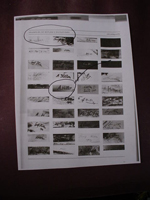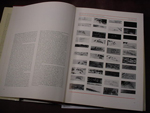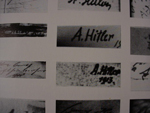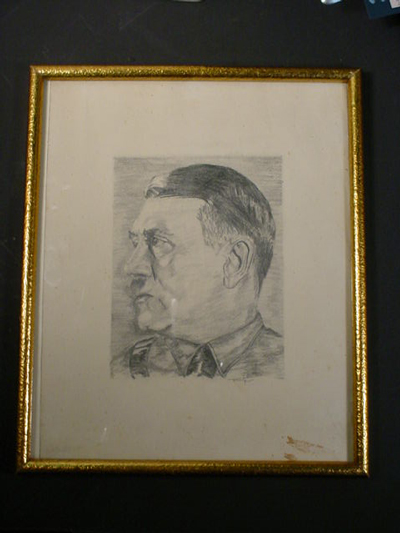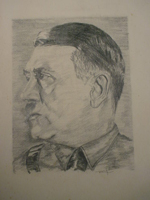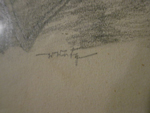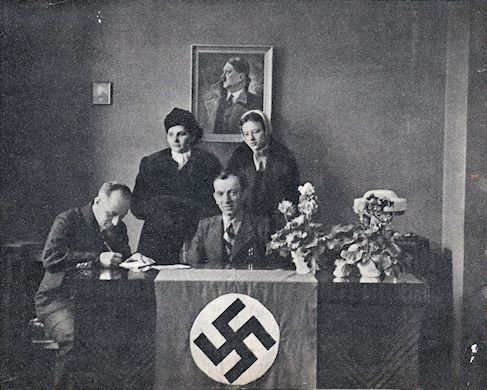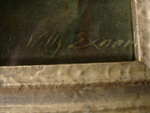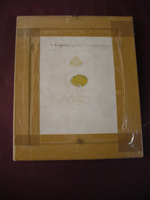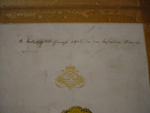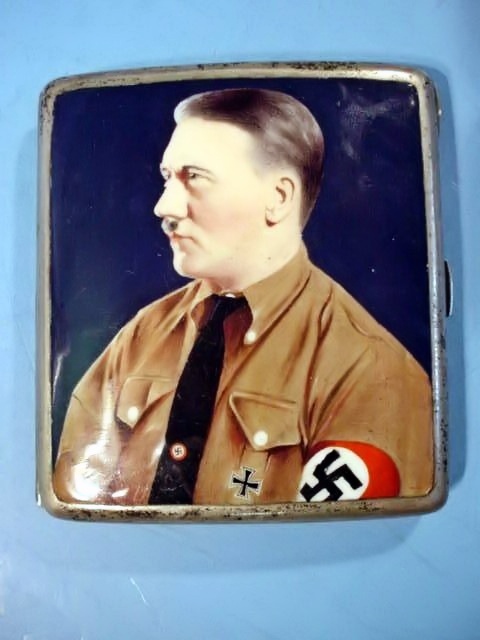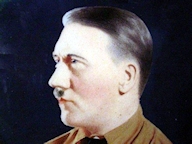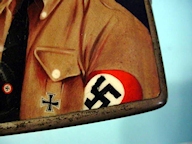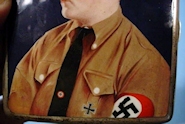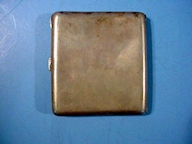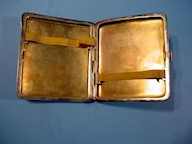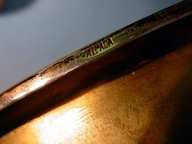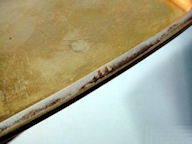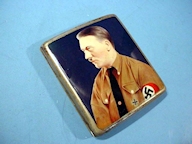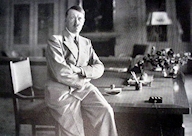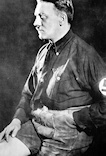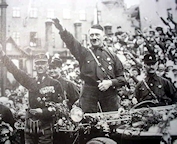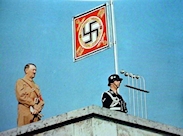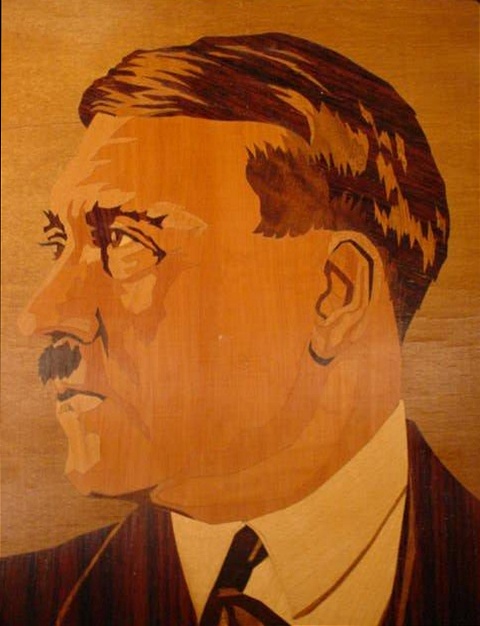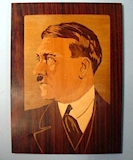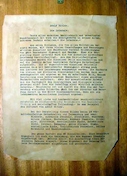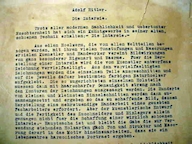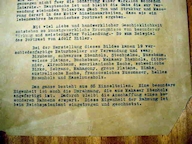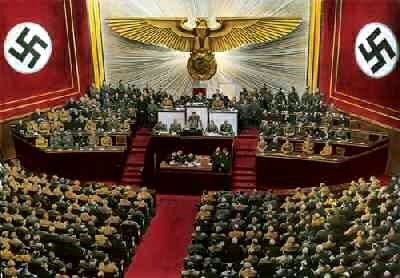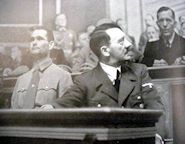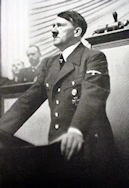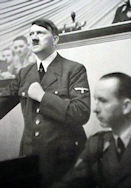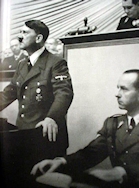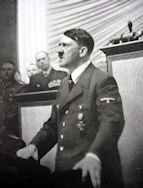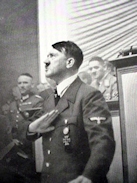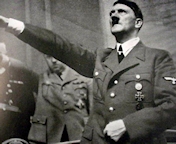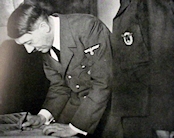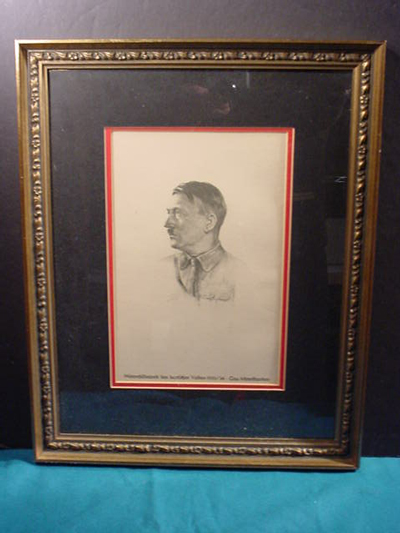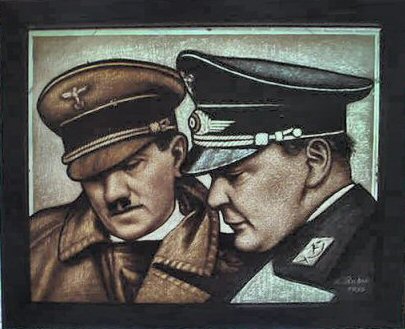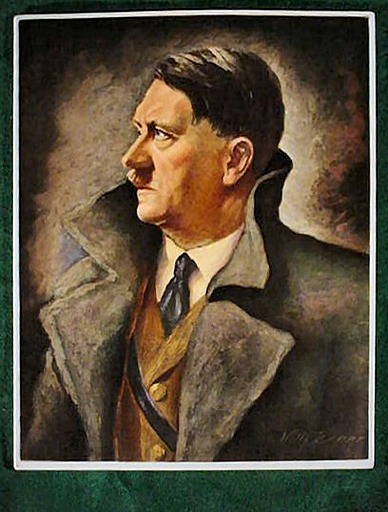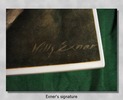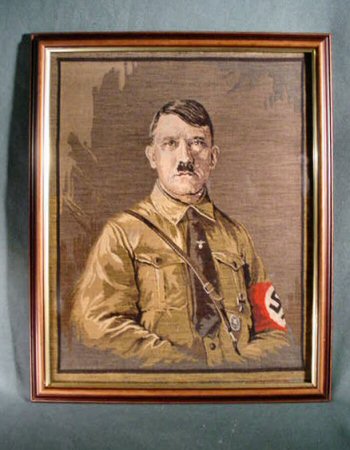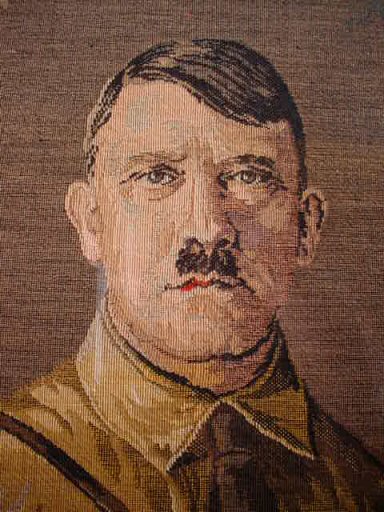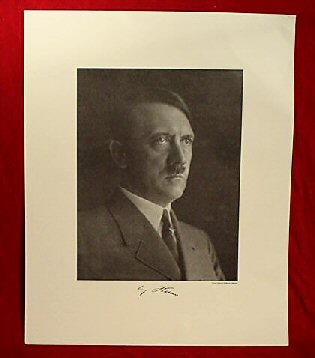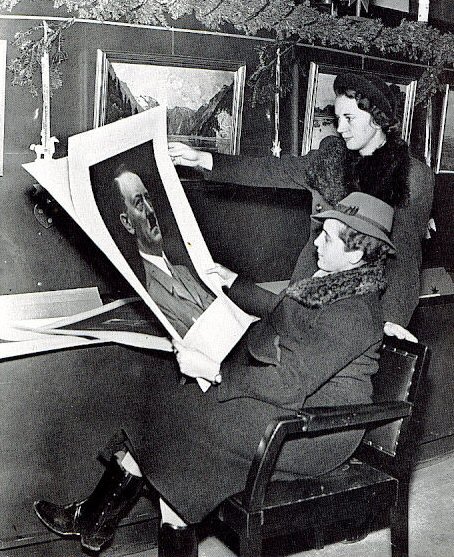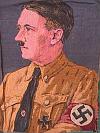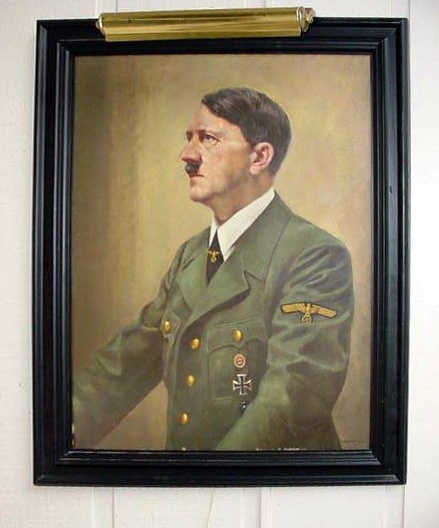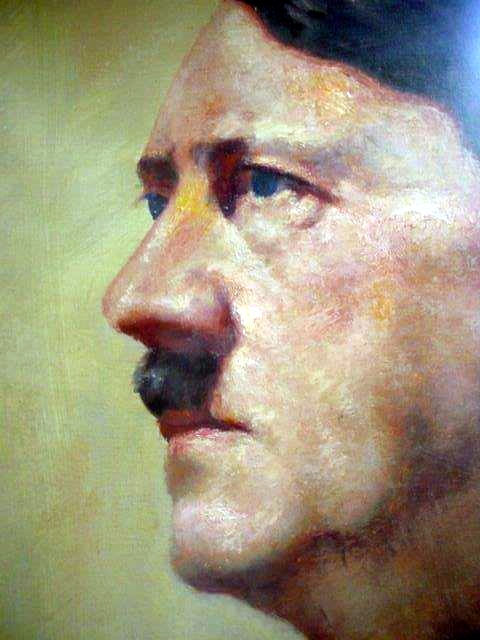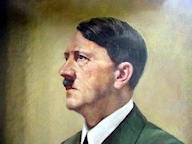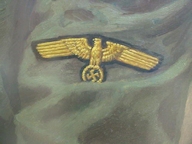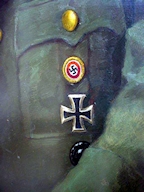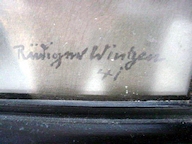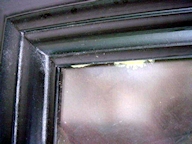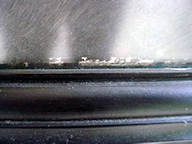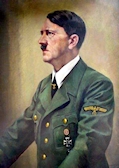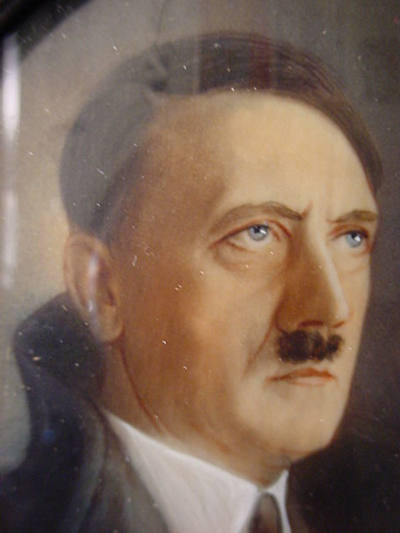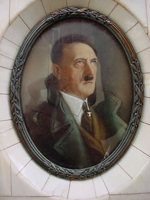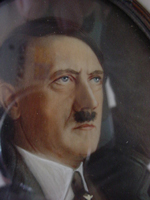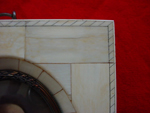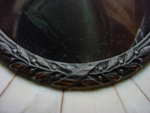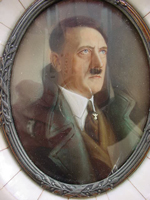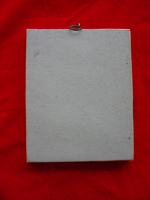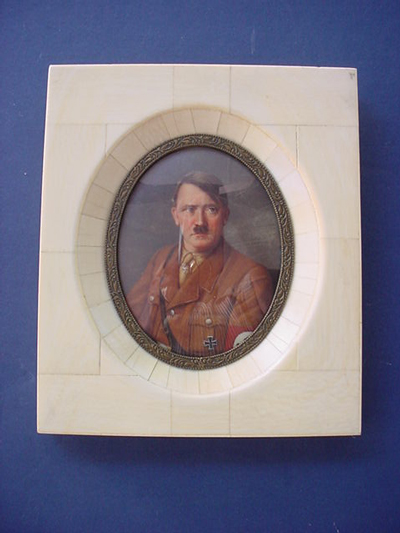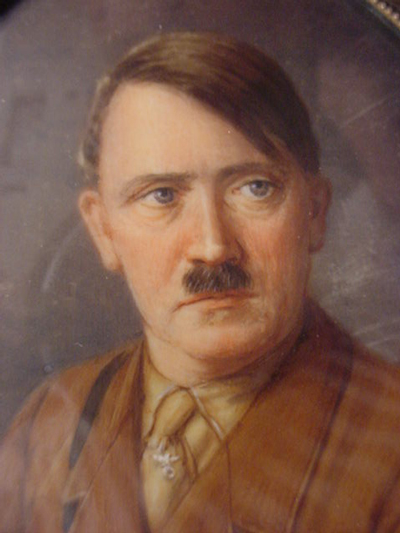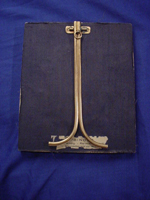DESCRIPTION: Here is the finest painting of the Führer that we have ever encountered. The artist is Otto Vittali (1872-1958). He lived in Offenburg. He was half Italian, his forefathers having immigrated in 1804 from Bellano Province, Como, Italy. He studied at the art schools in Karlsruhe and Munich and worked later in the studio of Professor Linnemann in Frankfurt. His father was famous for glass painting. Young Otto thought to someday take over his father’s art and he made a scholastic trip to America. The young man made himself independent and perfected his skills in Berlin. Here he received significant orders because of his overriding skill. He received several commissions from the Hohenzollern Imperial Palace. The orders from royalty were usually requests to do heraldic window hangings; in German Fensterglasbilder. These beautiful hand-painted items were considered national treasures In Germany. If you would like to see some wonderful examples of these art forms be sure to visit our Kaiser Reich section at Heraldic Window Hangings . He also did many stained-glass windows for the churches and cathedrals to include the German National Cathedral in Berlin and also the famed Kaiser Wilhelm Gedächtniskirche (Memorial Church) located on the Kurfürstendamm in Berlin. This was the place of worship for the family of Kaisers Wilhelm I and II. Vittali painted seven church-window scenes by order of the Prussian empress and by order of Kaiser Wilhelm II. He painted the famed painting of the Ascension Church of the Mount of Olives in Jerusalem. He also painted the frieze in the garden façade of the Hotel Adlon in Berlin. Vittali helped in the construction of this famed hotel while on an artistic advisory board. In 1910, he studied ceramic art in Paris. He also invented a machine for the production of autotype low-pressure grips. Other inventions too numerous to recount were processed by this man who absolutely bordered on genius. No doubt, there would have been much more if WWI had not intervened against these hopeful developments. He now became a soldier and an artillery officer; he invented a graphic flight-path table that made the earlier artillery calculations superfluous. He then found some time to turn to portrait painting as well as landscape scenes. He portrays military generals and creates some fine depictions of Polish peasants and their daily lives. He created very impressive pictures of the wide Polish-Russian countryside; many of these are still in the family estate. After the war, he drew and designed etchings, original stone drawings, ex-libris plates, and illustrations for books plus technical and promotional drawings for various large cooperations. He loved to paint scenes from his beloved Baden countryside. These often were oversized renderings. He painted portraits of many important people in the Markgräflerland, and priests, lawyers, and many paintings of the town buildings of Offenburg, the medieval town that existed from 1163. The list of his rich artistic masterpieces are legion. Some of the ones of gathering thunderstorms in the Black Forest and many others when found today are certainly treasured. Up to 1953, he counted 1,593 pictures and 689 portraits, and not counted are the countless watercolors and sketches as well as his wonderful examples of glass paintings. Badenland should have the works of Otto Vittali posted highly in her honorary hall. The glorification on art of Baden’s lovely scenery by this master should never be lost to future generations.
The Painting
The masterpiece was done by Vittali in 1933. This was the year of the “Machtergreifung,” the ascension to power of the National Socialist German Workers’ Party or NSDAP. Adolf Hitler had just been appointed Reich’s Chancellor by President Paul von Hindenburg and all patriotic Germans were in absolute ecstasy including, of course, the artists. Many works of art both professional and amateurish emerged with motifs of Hitler and his NS Party. However, having collected and studied numerous Hitler portraits of the period, we must hasten to add that never have we ever observed a better likeness of the German leader as this one from the brush of Otto Vittali. It’s almost as if Hitler actually sat for this amazing portrait. The colors, the detailing, the stark realism are so evident as to easily be called a more than an excellent rendering, if not a masterpiece. The Führer looks like he could speak! Please forgive my exaggeration if it could be said to be such, but we have seldom been so completely awestruck with a painting in our long career in this field.
The Painting’s Story
The canvas measures 19 ½ x 20 inches and in the frame it is 28 ½ x 23 inches. (We had it eventually framed). There is damage to the surface as you can readily see, but the face is pretty much undamaged; to be repaired would be an easy project for a professional art restorer. Now, how did it get this minimal damage? Let’s go back to 1945 in Munich. A certain GI was assigned to duty at Munich’s Rathaus (city hall). He was designated a guard while the army intelligence team was sorting things from room to room, office to office. The Rathaus is huge. Our GI noticed that not only those so-called Monuments Men were hard at work but also certain officers were in and out for three days hauling off souvenirs and some of them even bragged about it to him. The GI was sternly warned however that if he were to even touch anything he would be in a “world of trouble.” This order rather stuck in his craw. Why should the brass be able to loot everything while a common dogface should be denied? So, on his third day of duty there, he entered a room that had a huge, long table and more than 25 chairs all with carved swastikas on them. There was also a speaker’s rostrum and inside the hollowed back of that rostrum sat this portrait of Hitler in a frame. He deduced by the holes in the wall behind that this picture probably hung there behind the speakers and how the officers had missed this he couldn’t imagine because of the obvious beauty of the rendering and frankly, because he had found no significant war trophy yet he decided to have it. Yet, he knew he could be charged with theft if he was caught as he tried to get it out in its heavy frame so after thinking about it, he decided to cut it from the frame with his pocket knife. He did this carefully and then he removed his shirt and undershirt and wrapped it around his trunk and secured it with his boot strings. It was four hours until the end of his tour of duty and he had to wear this canvas under his shirt all that time. Many times various officers, MPs, and his own company commander passed him and he said he was a nervous wreck while hoping nothing would be discovered. Later, far from that scene, he had to declare the piece to a declarations captain at Infantry HQ Command #1873 and that captain, who had no knowledge of the city-hall incidents, examined the four articles that the GI declared. (He successfully had added this great painting to his treasure trove). After it was bought there was a phone call from him and he said he had a medal on a string that he had found on the back of the frame that he removed and he had over the years forgotten about it. He said this medal—as he called it—was fastened to the back of the original picture frame and at the time he removed it he shoved it in his pocket and now he sent us a photo of it. To make it even more exciting, he wanted more money for this and when we saw what it was we felt it should be bought. The medallion is a bronze fob-style affair that has the Athena figure with the National Socialist eagle and the Torch of Enlightenment and it says along its edges: “AUSGESTELLT IM HAUS DER DEUTSCHEN KUNST 1941.” Translated it has the meaning that this painting could have been displayed at the House of German Art in Munich; however, when we searched our catalogues from the 1940s, we could find no record of a Vittali painting ever put on official exhibition at the gallery. However, the word “ausgestellt” has several meanings according to our translator. First, it can mean ‘displayed’ or ‘to be on display” as in to possibly be on display at the museum. Obviously, the latter seems to be the case in 1941. With the war already raging for Germany, turmoil was evident on every front; military and civil. The museums were short staffed and much of the staff were now soldiers or very involved in wartime necessities. From the museum’s opening in 1937, staff meetings with artists were held on a regular basis and certain artistic themes were discussed and appropriate themes for the particular time were chosen. Our theory is that Vittali’s Hitler painting was decidedly more than worthy of being considered and that is why he was given the medallion with the promise of future inclusion in the galleries. This was in 1941 and Vittali’s portrait shows the Führer dressed in the uniform of the earlier Kampzeit brown uniform (Kampzeit: struggle for power) and from 1939 on he was always dressed in the grey-green uniform that he swore to wear until Germany was victorious. Well, as fate would have it, the Vittali painting never did make it as far as actually being displayed at the gallery of the museum. It is only too bad that it was not entered in 1937 or 1934 because if that would have been the case we are sure it would have been right there on the gallery wall along with many other images of “der grosse Befreier,” Adolf Hitler. But it did make it to an honored place on the wall of the Munich City Hall. We are most thrilled that we were able to procure this precious medallion along with the treasured portrait. Maybe Otto Vittali’s painting never made it to the Haus der Deutschen Kunst, but the fact that he was considered seems to confer the possible title of “masterpiece” in this, his work. We are told that between 3,000 and 4,000 artworks would be considered by the museum’s directors and advisors each July and fewer than 100 were annually selected to be in the class of semifinalists and then out of these 30 to 40 ended up being chosen for actual exhibition, while some of the best considered excellent were often scheduled for later consideration and the artist is issued the coveted medallion. Therefore, here is the portrait that Germania International is so very proud to present to the collector world. The condition is as seen in our images presented. The damage comes from the rather novel way that our GI looter chose to convey it past all the brass and MPs. It is fortunate that the actual countenance of the Führer is pretty much undamaged and can, as we indicated, be rather reasonably restored. Here is a chance to procure for yourself a true artistic treasure of that world’s shaking turbulent time and a prodigiously great historically important objet d’art.
PRICE: $58,000.00; includes the portrait in oil and the House of Art medallion. This is a great and stupendous investment offered at this time. Its value can only go UP!
|


